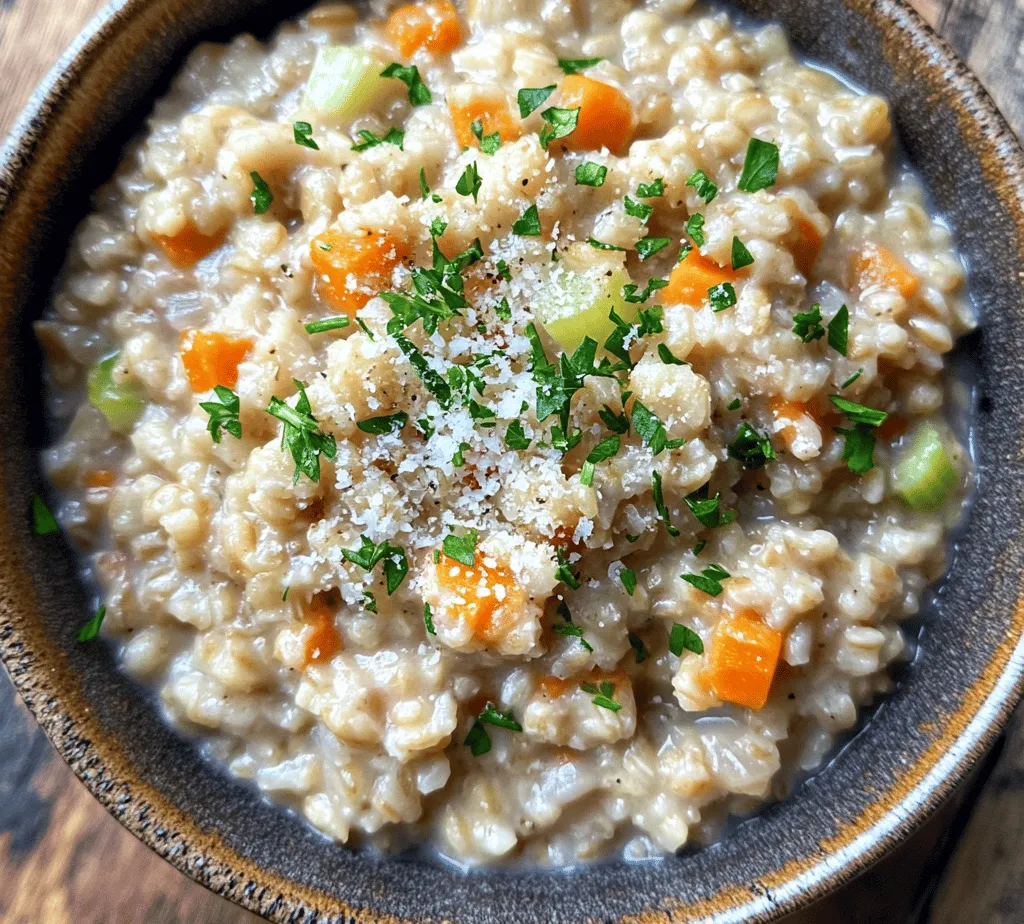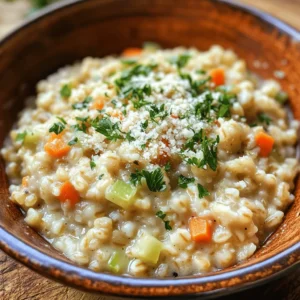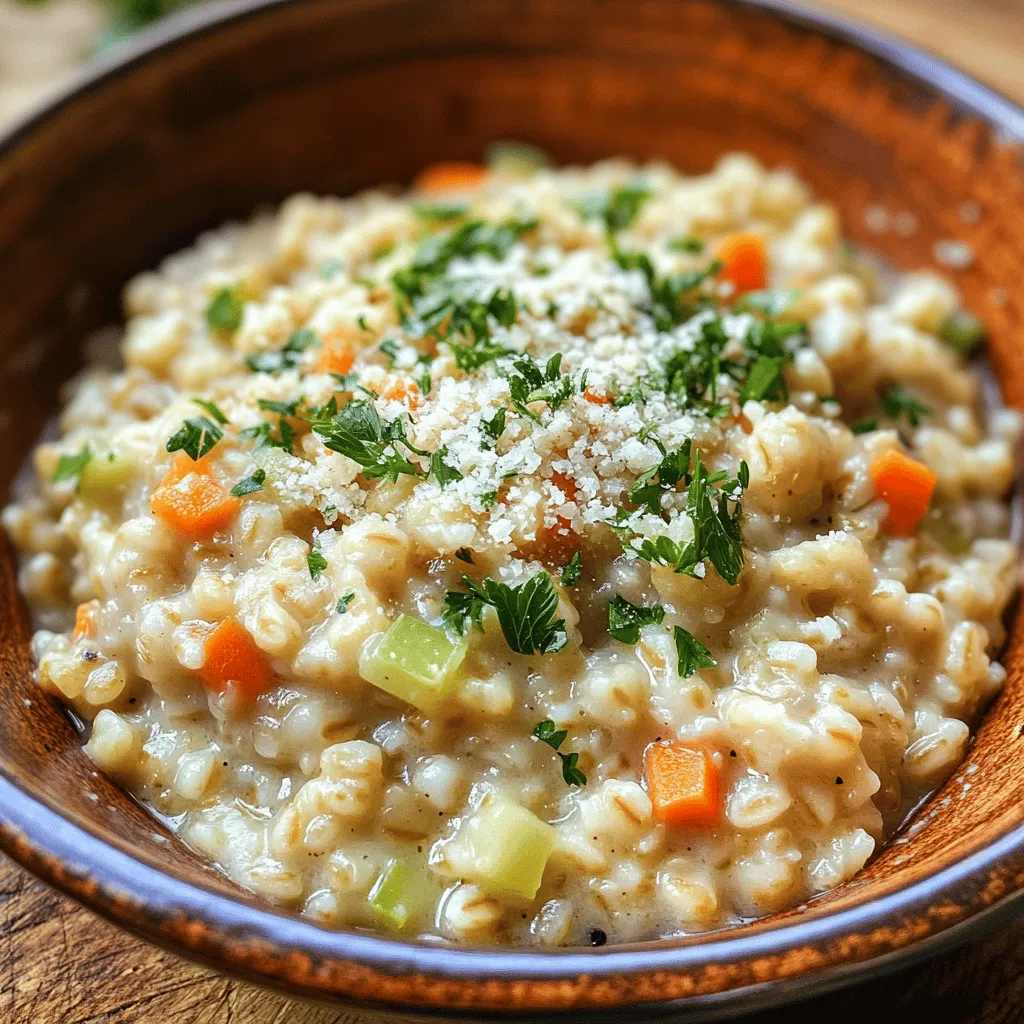Introduction
Barley is one of the oldest cultivated grains, revered for its rich flavor and impressive nutritional profile. As a whole grain, it has gained popularity in recent years due to its numerous health benefits and versatility in various dishes. Today, we’ll explore the delightful world of hearty barley porridge—a comforting dish that not only warms the soul but also nourishes the body.
Barley porridge is more than just a breakfast option; it is a wholesome meal that can be enjoyed any time of the day. Its creamy texture and nutty flavor make it a satisfying alternative to oatmeal or rice porridge. Rich in fiber and essential nutrients, barley porridge is an excellent choice for anyone looking to add more whole grains into their diet.
In this article, we will delve into the health benefits of barley and its adaptability in meals. We will also provide a comprehensive recipe for hearty barley porridge, highlighting simple and wholesome ingredients that make it an easy yet delicious dish to prepare at home.
Understanding Barley: A Nutritional Powerhouse
Pearl barley, the most common form of barley used for cooking, is a whole grain that has been polished to remove the outer bran layer. This process results in a tender grain that cooks relatively quickly while still retaining many of its nutritional benefits. With a chewy texture and a mild, nutty flavor, pearl barley is an excellent base for porridge.
Nutritional Profile of Pearl Barley
Barley is a remarkable source of dietary fiber, which can help promote digestive health and keep you feeling full longer. In fact, just one cup of cooked pearl barley contains around 6 grams of fiber, which is more than many other popular grains. This high fiber content aids in regulating blood sugar levels, making it a smart choice for anyone looking to maintain stable energy throughout the day.
In addition to fiber, barley is rich in protein, providing about 3.5 grams per cooked cup. It’s also a good source of essential vitamins and minerals, including B vitamins (like niacin and thiamine), iron, magnesium, and selenium. These nutrients play a crucial role in energy production, immune function, and overall health.
Comparison to Other Grains
When compared to other grains, barley stands out for its impressive fiber content, which surpasses that of rice, quinoa, and even oats. While oats are often heralded for their health benefits, barley offers similar advantages with the added bonus of being low in gluten—making it a suitable option for those with gluten sensitivities.
Incorporating barley into your diet can help lower cholesterol levels, support heart health, and contribute to weight management. Furthermore, with its low glycemic index, barley can be a great choice for individuals looking to control their blood sugar levels, making it a wholesome addition to various meals.
Different Types of Barley and Their Uses in Cooking
While pearl barley is the most commonly used variety in porridge, there are other types of barley worth exploring. Hulled barley, which is less processed and retains its bran layer, is higher in fiber and nutrients compared to pearl barley but takes longer to cook. It is often used in salads and stews, offering a chewy bite that can enhance a variety of dishes.
Another type, barley grits, is coarsely ground barley that can serve as a base for pilafs or porridge, providing a unique texture. Exploring these different forms of barley can open up new culinary possibilities, allowing you to enjoy its health benefits in various ways.
Ingredients Breakdown
For this hearty barley porridge recipe, we will use simple yet nourishing ingredients that are easily accessible. Here’s a detailed breakdown of each ingredient, including optional variations to customize your dish.
Base Ingredients
1. Pearl Barley: The star of our porridge, pearl barley provides a chewy texture and nutty flavor. It is essential for creating the hearty base of the dish.
2. Vegetable Broth or Water: Using vegetable broth instead of water adds depth and flavor to the porridge. Opt for low-sodium broth to keep the dish healthy and flavorful.
3. Fresh Vegetables: Adding vegetables like diced carrots, celery, or spinach can enhance the nutritional value of the porridge. Fresh produce brings color, flavor, and additional vitamins to the dish.
4. Herbs and Spices: Fresh herbs like thyme or parsley can elevate the flavor profile of the porridge. Adding spices such as black pepper, garlic powder, or onion powder can also bring warmth and depth to the dish.
Optional Ingredients
1. Cheese: For a creamy finish, consider stirring in some grated cheese, such as parmesan or feta. This addition can enhance the richness of the porridge and provide a savory contrast to the grains.
2. Nuts and Seeds: Toasted nuts or seeds, such as walnuts or pumpkin seeds, can add a satisfying crunch and extra protein.
3. Fruits: For those who prefer a sweet twist, adding fruits like sliced bananas, berries, or dried fruits can create a deliciously sweet porridge. A drizzle of honey or maple syrup can provide natural sweetness.
Importance of Fresh Produce and High-Quality Grains
When preparing barley porridge, using fresh vegetables and high-quality grains is crucial for achieving the best flavor and texture. Fresh produce not only enhances the taste but also ensures you’re getting the maximum health benefits. Look for organic or locally sourced vegetables whenever possible to support sustainability and enjoy the freshest ingredients.
Similarly, choosing high-quality grains ensures that you are getting a nutritious and flavorful base for your dish. Look for certified organic pearl barley or whole grain barley to maximize the health benefits of your porridge.
Customization Ideas
One of the great things about barley porridge is its versatility. You can easily customize the ingredients based on your preferences or what you have on hand. Experiment with different vegetables, herbs, and spices to create a unique flavor profile that suits your palate. Additionally, consider making a batch of porridge ahead of time and reheating it for quick breakfasts throughout the week.
Step-by-Step Instructions for Perfect Barley Porridge
Now that we’ve covered the nutritional benefits and ingredients, let’s dive into the step-by-step instructions for preparing hearty barley porridge. This simple yet satisfying recipe will guide you through the cooking process, ensuring your porridge comes out perfectly every time.
1. Rinse the Barley: Start by rinsing 1 cup of pearl barley under cold running water. This step helps remove any dust or impurities and ensures a clean cooking experience.
2. Sauté the Vegetables (Optional): In a large saucepan, heat a tablespoon of olive oil over medium heat. If you’re adding vegetables, such as diced onions, carrots, or celery, sauté them for about 3-5 minutes until they are softened and fragrant. This step will infuse the base of the porridge with delicious flavors.
3. Add Barley and Broth/Water: Once your vegetables are ready, add the rinsed pearl barley to the saucepan. Pour in 4 cups of vegetable broth or water. Stir the mixture to combine the ingredients evenly.
4. Bring to a Boil: Increase the heat to high and bring the mixture to a boil. Once boiling, reduce the heat to low, cover the saucepan, and let it simmer.
5. Simmer Until Tender: Allow the barley to simmer for about 30-40 minutes, or until it becomes tender and has absorbed most of the liquid. Stir occasionally to prevent sticking and ensure even cooking.
6. Season to Taste: After the barley is cooked, taste your porridge and season it with salt, pepper, and any additional herbs or spices you prefer. Stir well to incorporate the seasonings.
7. Serve and Garnish: Once seasoned, remove the saucepan from the heat. Serve the hearty barley porridge in bowls and garnish with your choice of toppings, such as grated cheese, fresh herbs, nuts, or a drizzle of olive oil.
This step-by-step guide will help you achieve a perfectly creamy and flavorful hearty barley porridge, ready to be enjoyed any time of the day.
Stay tuned for the next section of this article, where we will explore additional tips for making the best barley porridge and answer some common questions about this nutritious dish.

Visual Cues for Texture and Consistency
When preparing hearty barley porridge, understanding when your barley is perfectly cooked is crucial for achieving the right texture. Barley should be tender yet slightly chewy—this balance is what makes it an appealing choice for porridge. As you cook, keep an eye on the grains. Ideally, they will swell and soften, absorbing the broth or water while still maintaining a bit of firmness in the center.
A good visual cue to determine doneness is the appearance of the barley; it should have expanded in size and take on a plump, round look. If you taste the barley, it should not be mushy but offer a delightful chewiness. Typically, pearl barley takes about 30 to 40 minutes to cook, while hulled barley may require a longer cooking time of up to 60 minutes. Keep this in mind as you adjust your cooking duration based on the type of barley used.
Importance of Rinsing Barley and Sautéing Vegetables for Flavor Development
Rinsing barley before cooking is a small but vital step that can significantly enhance the flavor of your porridge. By washing the grains under cold water, you remove excess starch and any residual dust, leading to a cleaner taste. This step also helps prevent the porridge from becoming overly gummy.
Sautéing vegetables before adding them to the pot can further elevate the dish’s flavor profile. When you sauté aromatics like onions, garlic, or even spices, the heat brings out their natural sweetness and deepens their flavors. This technique creates a robust base for your porridge, allowing the barley to absorb all the delicious nuances of the sautéed ingredients.
Tips for Achieving the Right Balance of Seasonings and Texture
Finding the perfect balance of seasonings in your hearty barley porridge can elevate the dish from ordinary to extraordinary. Start with a base of salt, as it enhances and brings out the flavors of the other ingredients. Consider adding herbs like thyme, rosemary, or bay leaves during the cooking process for a fragrant touch.
For a hint of spice, a dash of black pepper or a sprinkle of red pepper flakes can provide a pleasant warmth. Remember that spices intensify as they cook, so start with small amounts and adjust to your taste.
Texture is equally important; if you prefer a creamier porridge, consider adding a splash of milk or a dollop of yogurt just before serving. Alternatively, for a heartier texture, leave the porridge thicker by reducing the liquid slightly or incorporating more barley. Adjust the consistency according to your preference, whether you like it soupy or more solid.
Flavor Enhancements and Variations
To personalize your hearty barley porridge, consider incorporating additional ingredients that complement the base flavors. For a protein boost, you might add cooked chicken, turkey, or roasted chickpeas for a vegetarian option. These additions not only enhance the nutritional profile but also contribute satisfying textures.
Seasonal variations can also bring new life to your porridge. In the fall, consider adding diced butternut squash or apples for a sweet and savory contrast. In the spring and summer, vibrant vegetables such as zucchini, peas, or asparagus can brighten the dish and provide a refreshing taste. These seasonal enhancements allow you to enjoy barley porridge year-round, adapting to the produce available in your region.
Pairing suggestions are also vital in creating a balanced meal. A light salad or sautéed greens can complement the hearty nature of the porridge, providing a refreshing counterbalance. Additionally, a drizzle of balsamic glaze or a sprinkle of feta cheese can add a gourmet touch while enhancing flavor.
Serving Suggestions
Barley porridge is versatile and can be enjoyed at any meal of the day. For breakfast, consider a sweet version by adding honey, fresh fruit, and nuts. This approach transforms the porridge into a nutritious start to your day, packed with fiber and energy.
For lunch or dinner, serve the hearty porridge as a base for grilled meats or roasted vegetables. A beautiful presentation can make all the difference; serve the porridge in a deep bowl, topped with colorful vegetables and a sprinkle of herbs for visual appeal. A drizzle of olive oil or a splash of lemon juice can add a finishing touch, enhancing both flavor and aesthetics.
When it comes to storing leftovers, barley porridge keeps well in the refrigerator. Allow it to cool, then transfer it to an airtight container. It can be stored for up to three days. When reheating, add a splash of water or broth to restore moisture, ensuring the porridge remains creamy rather than drying out.
Health Benefits of Hearty Barley Porridge
The ingredients in hearty barley porridge contribute significantly to its health benefits. Barley is a whole grain rich in fiber, particularly beta-glucan, which is known for its ability to help lower cholesterol levels. The high fiber content also aids in digestion and promotes a feeling of fullness, making it an excellent choice for those looking to manage their weight.
In addition to barley, the vegetables and proteins you choose to include will enhance the dish’s nutritional value. For instance, adding greens like spinach or kale introduces essential vitamins and minerals, while beans or lentils provide plant-based protein.
For those with dietary restrictions, barley can be adapted to fit various needs. While it contains gluten, individuals seeking gluten-free options can substitute barley with quinoa or gluten-free oats. For a vegan meal, simply omit any animal proteins and use vegetable broth for cooking.
Conclusion
Hearty barley porridge is more than just a meal; it’s a nourishing, versatile dish that can be customized to suit your tastes and dietary preferences. With its rich texture and ability to absorb flavors, barley serves as a perfect canvas for an array of ingredients and seasonings. Whether you enjoy it sweet for breakfast or savory for lunch or dinner, this porridge is a wholesome staple that can easily fit into a balanced diet.
We encourage you to experiment with this recipe, trying different combinations of vegetables, proteins, and seasonings. The beauty of barley porridge lies in its adaptability, allowing you to make it your own while reaping the health benefits of whole grains. Embrace barley as a staple ingredient in your kitchen, and let it inspire your culinary creativity for hearty, healthy meals.



